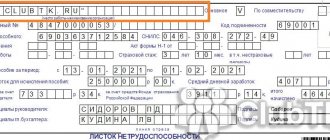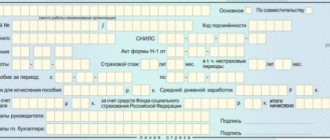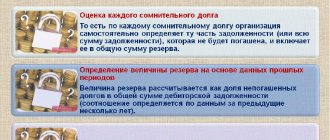What is the order of payment in a payment order for writs of execution?
The fact is that it is impossible to receive any government service without first confirming that the fee has already been paid to the budget on an initiative basis. Also see “Payment order for payment of state duty to the arbitration court: sample”. Dividends If we are talking about the distribution of profits between business owners, then for dividends the order of payment in the payment order is set to the latest - the fifth. From the state's point of view, they do not have priority over any other payments. Also see “Dividend Payment Period”. What to do if the priority is indicated incorrectly If there are enough amounts in the client’s current account to make all declared and necessary payments, then the priority indicated in the order does not play a fundamental role. All payment orders will be executed by the bank in the order they are received.
How to fill out a payment order correctly?
A payment order (PP) is drawn up in form 0401060, approved by Bank of Russia Regulation No. 383-P dated June 19, 2012, but it is not mandatory for use.
To fill out the order correctly, it is recommended that you familiarize yourself with the rules and information about what information is indicated in a specific field:
- Field 21: order of payment. The number “1” is put here, because alimony is considered a priority. First, write-offs are made for them, then for other obligations.
- Field 17: Recipient's current account. The account details of the ex-wife are indicated where the money should be transferred.
- Field 19: payment term. Remains empty.
- Field 24: purpose of payment – “alimony”.
- Field 60: Payer's TIN. For individuals – 12 digits, for legal entities – 10.
In total, there are about 110 fields in the order, but the above ones are the most important when paying alimony.
Important! Payments for the maintenance of a minor must be transferred monthly no later than 3 days from the date of payment of wages. For failure to meet deadlines, you will have to pay a penalty - 0.1% of the debt for each day of delay.
Order of payment in a payment order: what to put in field 21 in 2021
Sequence of payment - definition Sequence of payment is the sequence established in the Civil Code of the Russian Federation for the bank to write off funds from customer accounts based on received orders (settlement documents), the payment period for which has already arrived or is due on the day they are received by the bank. The payment queue does not depend on the types of orders received by the bank (payment orders, payment requests, collection orders, ...) to the client’s account, but depends on the availability of funds in this account and their sufficiency to pay for all received settlement (payment) documents. Where and with what symbols is the order of payment indicated? The order of payment is indicated in all types of customer orders.
The procedure for repaying debt under a writ of execution
Reading time: 5 min.
Any creditor can apply to the court with a statement of claim or a court order to collect the debt. However, this does not mean that after the deed is issued, the debtor will immediately repay the debt. That is why the debt is expected to be repaid under the writ of execution, already within the framework of enforcement proceedings. The bailiff service carries out write-offs of funds, inventory and seizure of property and other actions aimed at executing the act. In fact, we are talking about forced collection of debt within the established rules.
This is important to know: Application to the court to replace a party in enforcement proceedings: sample
Payment sequence: sequence of debiting funds from a bank account
In fact, this is one of the ways to protect family values. Mandatory payments of the 1st, 2nd, 4th and partially 3rd priority can be made by the bank without the client’s consent, since the basis for the transfer of money is an executive document. Therefore, in the generated payment order, the organization can only indicate the 3rd or 5th priority. The general principle of the queue is this: all payments that belong to one queue are executed in the calendar order of their receipt by the bank. How to correctly enter As for taxes, the order of payment in the 2018 payment order for their transfer in the corresponding line of the payment is “5” when there is a voluntary payment without any receipts from the Federal Tax Service. In turn, payment of taxes based on the requirements of the inspection must be carried out by the bank in third place.
Sample payment order
As mentioned earlier, the payment order form is approved by law, but you can deviate from it and use your own samples.
The document must contain the following information:
- number and date of registration of the PP;
- amount to be received by the bank and written off;
- payment type;
- information about the payer. Individuals indicate their full name and registration address, legal entities - name and address;
- recipient's name;
- recipient's account number;
- name of the payer's bank;
- name and address of the recipient's bank, BIC, subaccount number;
- payment queue – 1;
- code, signature and seal of the payer;
- bank marks - stamp and signature of employees. If the form is electronic – the date of execution of the order;
- date of receipt and debit from the bank. To be completed by authorized employees of the financial institution;
- checkpoint between payer and recipient;
- KBK, code OKTMO.
It is important to take into account that the order is drawn up in 4 copies:
- the first one remains in the bank after debiting,
- the second is kept in the documentation for the recipient bank,
- the third is attached to confirm the bank transaction to the recipient’s account statement,
- the fourth is returned to the payer to confirm the transaction.
Alimony order of payment
The company's accounting department monitors the sending of a payment order for each reporting period on this issue to the banking institution, where clear deadlines for the deduction of funds are indicated. The banking institution makes money transfers based on the established priority. The order of payment is a point of decisive importance in conditions of limited financial resources of a legal entity.
There may be situations when a company has the ability to make only part of the mandatory payments: wages, transfer of fees and taxes, transactions to the Pension Fund, etc. Regulation of this issue is regulated by Article 855 of the Civil Code of Russia, which establishes the rules for priority payments for alimony, as well as for compensation for all kinds of damage.
Refund sequence
If a person repays the money he borrowed according to a writ of execution, then he must retain part of his income. In accordance with the current legislation of the Russian Federation, this amount must be at least half of the defaulter’s salary.
If there are several debt obligations at once, the return of which is made through the court, the citizen also retains at least 50% of the salary. In this case, it is necessary to follow the collection sequence. This is a very important point, since the law stipulates in what order repayments must be made.
If one person in an organization has several documents for one employee, then compensation of the debt under the writ of execution is made in accordance with the rules.
The order of payment in the payment order
Fine The exact order of the fine in the payment order depends not on its type (tax/administrative, etc.), but on the order in which it is entered into the budget. If a person pays it of his own free will and the controllers have not received a corresponding order or receipt, then this will be the 5th stage. In the opposite situation - 4th line. State duty As for the state duty, the order of payment in the payment order is almost always “5”.
Collections from wages are made from an officially employed debtor in the amount that was specified in the alimony agreement or appointed by the judicial authority. The company's accounting department carries out the appropriate calculations and draws up a special payment order for the purpose of transferring funds to the alimony collector. The bank observes the order of payment and its timely transfer.
Payment order is a document that has been subject to changes regarding the order of payments. Alimony (according to the law) is a priority deduction. When filling out this document, the accountant puts the number 1 in column number 21, which confirms the priority of this payment.
If the debtor has obligations under several writs of execution, then the debt is repaid in accordance with the scheme described above.
Deductions from the income of a convicted person
Situation: in what order should deductions be made to state income from the salary of an employee sentenced to correctional labor - before or after withholding personal income tax?
Calculate the amount of deductions from your salary before deduction of personal income tax.
The consequence of punishment in the form of correctional labor is the withholding of part of the prisoner’s salary at the main place of work to the state income in the amount established by the court verdict (Part, Article 50 of the Criminal Code of the Russian Federation, Part 2 of Article 40 of the Penal Code of the Russian Federation). Withholding can be assigned in the range from 5 to 20 percent of the salary (Part 3 of Article 50 of the Criminal Code of the Russian Federation).
Calculate deductions from the day the convicted person went to work (from the date the sentence began). This conclusion follows from paragraph 82 of the Instruction, approved by order of the Ministry of Justice of Russia dated May 20, 2009 No. 142. Withhold part of the employee’s earnings for each month worked when paying him a salary, and then transfer it to the appropriate budget (Parts 2 and 3 of Article 44 PEC RF).
Calculate the amount of deductions from the entire earnings of the convicted person without deducting personal income tax. The fact is that the provisions of Article 44 of the Criminal Executive Code of the Russian Federation require deductions from the entire amount of wages (both in cash and in kind). At the same time, the Criminal Executive Code of the Russian Federation does not contain a special clause stating that deductions must be calculated from the amount remaining after calculating personal income tax, as is done, for example, in relation to deductions under writs of execution in Article 99 of Law No. 229- dated October 2, 2007 Federal Law.
Deductions are part of the prisoner's salary. Therefore, when calculating personal income tax, include in the employee’s income the entire salary accrued to him (without deduction of deductions) (clause 1 of Article 210 of the Tax Code of the Russian Federation).
An example of how to reflect in accounting and taxation the withholding of part of the salary of an employee sentenced to correctional labor
The Alpha accountant, on the basis of a court verdict, withholds 20 percent of the monthly salary of worker A.I. Ivanov, sentenced to correctional labor. Alpha transfers the retained amount to the budget.
Alpha charges premiums for insurance against accidents and occupational diseases at a rate of 0.2 percent.
Ivanov’s salary is 30,000 rubles. Ivanov has no children, so he is not provided with standard personal income tax deductions.
The Alpha accountant withheld part of Ivanov’s salary according to a court verdict: 30,000 rubles. × 20% = 6000 rub.
The amount of personal income tax in January is: 30,000 rubles. × 13% = 3900 rub.
The following entries were made in Alpha's accounting.
January (calculation of salaries, taxes and contributions, withholding of part of the salary by court verdict):
Debit 26 Credit 70 – 30,000 rub. – Ivanov’s salary was accrued.
"Alpha" does not belong to the category of organizations that can apply reduced contribution rates for compulsory pension (social, medical) insurance. Ivanov’s income has not exceeded the contribution limit since the beginning of the year. Therefore, Alpha’s accountant assessed contributions for compulsory pension (social, medical) insurance from Ivanov’s income at a cumulative rate of 30 percent.
Debit 26 Credit 69 subaccount “Settlements with the Pension Fund” – 6600 rubles. (RUB 30,000 × 22%) – pension contributions accrued;
Debit 26 Credit 69 subaccount “Settlements with the Social Insurance Fund for social insurance contributions” – 870 rubles. (RUB 30,000 × 2.9%) – social insurance contributions are calculated;
Debit 26 Credit 69 subaccount “Settlements with FFOMS” – 1530 rubles. (RUB 30,000 × 5.1%) – contributions for health insurance to the Federal Compulsory Medical Insurance Fund are accrued;
Debit 26 Credit 69 subaccount “Settlements with the Federal Social Insurance Fund of Russia for contributions to insurance against accidents and occupational diseases” – 60 rubles. (RUB 30,000 × 0.2%) – premiums for insurance against accidents and occupational diseases have been calculated;
Debit 70 Credit 68 subaccount “Personal Income Tax Payments” – 3900 rubles. – personal income tax withheld;
Debit 70 Credit 76 subaccount “Calculations for deductions from the salary of a person sentenced to correctional labor” - 6,000 rubles. – part of the salary was withheld according to a court verdict.
February (payment of wages, transfer of deductions by court verdict to the budget):
Debit 70 Credit 50 – 20 100 rub. (30,000 rubles – 3900 rubles – 6000 rubles) – Ivanov’s salary was issued from the cash register (minus deductions);
Debit 76 subaccount “Calculations for deductions from the salary of a person sentenced to correctional labor” Credit 51 – 6000 rubles. – the amount deducted from the employee’s salary following a court verdict is transferred to state income.
Situation: is it necessary to withhold income from compensation for unused vacation in favor of the state if an employee sentenced to correctional labor is dismissed?
Answer: no, it is not necessary.
It is necessary to withhold income in favor of the state of a person sentenced to correctional labor only from the salary, and in the amount prescribed in the court verdict (Parts 1, 3 of Article 50 of the Criminal Code of the Russian Federation, Part 2 of Article 40 of the Penal Code of the Russian Federation).
And compensation for unused vacation is not salary. This is a one-time payment. Therefore, there is no reason to deduct from this compensation.
This follows from the provisions of paragraphs 2, 3 and 4 of Article 44 of the Criminal Executive Code of the Russian Federation. Such conclusions can be drawn from the letter of the Federal Penitentiary Service of Russia dated October 27, 2014 No. ref-16-50723.
An example of withholding part of the salary of an employee who is sentenced to correctional labor. Upon dismissal, he receives compensation for unused vacation
LLC "Torgovaya" is engaged in wholesale trade.
Organization manager A.S. Kondratyev was serving a sentence of correctional labor following a court verdict. According to the court decision, deductions from wages were made in the amount of 10 percent. The correctional period ended in January 2015. Immediately after completing the correctional work, Kondratyev wrote a letter of resignation. He is entitled to compensation for unused vacation in the amount of 8,330 rubles.
Kondratiev has no rights to deductions for personal income tax. Personal income tax on compensation amounted to: 8330 rubles. × 13% = 1083 rub.
The accountant did not withhold 10 percent of the compensation amount as state income.
In January, the Hermes accountant made the following entries:
Debit 44 Credit 70 – 8330 rub. – compensation for unused vacation has been accrued;
Debit 70 Credit 68 subaccount “Personal Income Tax Payments” – 1083 rubles. – personal income tax withheld;
Debit 70 Credit 50 – 7247 rub. (8330 rubles - 1083 rubles) - compensation was paid from the cash register (minus personal income tax).
When calculating income tax for January, the accountant included the entire amount of accrued compensation (RUB 8,330) in current expenses.
What is the order of payment in a payment order for writs of execution?
In payment documents, the order of payment (in field 21) is always indicated, although from all of the above we can conclude that the calendar order of payments is applied in the following cases:
- when there are enough funds in the account for all payments;
- within each (one) priority of payment when there are insufficient funds;
- when making all payments of the fifth priority.
So, from December 14, 2013, the number of payment queues decreased from 6 to 5 in accordance with the amendments introduced by Federal Law of December 2, 2013 N 345-FZ “On Amendments to Article 855 of Part Two of the Civil Code of the Russian Federation.”
That is, when taxes or contributions are forced to be paid. Then repay the amount of debt with a payment slip, in which in field 21 indicate the number 3. If you have identified the arrears yourself and have not yet received any demand for repayment, indicate the value “5” in the payment slips.
In other words, if there are not enough funds in the account, the demands of the Federal Tax Service for repayment of arrears (payment of fines, penalties) will be a priority. And then there will be requests from the payer company itself to transfer current obligatory amounts or repay its own debt. For personal income tax paid by a company (individual entrepreneur) in the status of a tax agent, no special procedure is provided. There will be a queue of 5 if the “income” is transferred voluntarily, albeit late. Queue 3 – in the case when payment is already a requirement of the auditors. As a general rule, code 3 is used for the current salary.
- various rewards to authors engaged in intellectual activity.
- Third priority – payments made on the basis of relevant documents and related to:
- payments for wages to persons who carry out activities under a contract (employment agreement),
- instructions from tax authorities (budget collections, payment of taxes, etc.);
- writing off or transferring debts incurred for fees, taxes, insurance premiums, etc.
- In fourth place are payments under enforcement documents related to the satisfaction of various monetary requirements.
- The fifth stage includes transfers for all kinds of payment documents in accordance with the established calendar priority.
Procedures for withholding alimony payments in 2017-2018.
Features of debt repayment under a “late” writ of execution
Despite the fact that the court decision indicates the exact date from which it is necessary to begin the process of writing off the employee, if the document was not received by the accounting department on time, then there is no need to withhold funds “retrospectively”. According to Art. 98 Federal Law No. 229, the employer is obliged to make contributions only from the moment of receipt of the sheet.
For example, the company has an employee who received such a document in August. It states that funds must be written off starting in June. But funds will be deducted only from August. In this case, the company’s accounting department must make all the necessary entries to be reflected in the report.
Additionally, it is possible to recover funds that were not withheld due to the delay of the writ of execution only using a separate document. The procedure is:
- After repayment of the principal debt, the bailiff draws up a new writ of execution.
- The underpaid funds are calculated.
- The received document is sent to the organization where the defaulter is employed.
There are rules for debt collection when receiving a writ of execution late
If this was not done, then the borrower has the right not to repay the balance. A valuable fact is that the borrower must be personally familiarized with all documents of a demanding nature received by the company’s accounting department. If the procedure for withholding funds is violated, the employee has the right to sue the employer or even challenge the sheet.
What is the order of payments?
At the legislative level in Art. 855 of the Civil Code of the Russian Federation, the priority (including the sequence of tax payments) in 2021 is defined as the procedure for writing off funds from the account. If there is a sufficient amount of money, the requirements are satisfied according to the rules for the calendar receipt of documents for transfer. If there are not enough funds in the account, and the number of transactions is significant, payments are carried out in a strictly defined order.
To indicate the priority in the payment order, field “21” is reserved. According to the Civil Code of the Russian Federation, there are 5 types of priority. This means that when filling out, the accountant will indicate a digital code - from “1” to “5”. For example, using code “3” the employer transfers wages to staff; and with code “5” – taxes to the budget. More detailed queue types are presented in the table below:
Digital queue designation
What payments are included?
Denotes payments under enforcement documents - primarily for alimony and compensation amounts to compensate for harm caused to the health or life of a citizen
Valid for payments under executive documents for the issuance of severance pay, salaries for dismissed employees, as well as for the transfer of amounts of royalties within the framework of intellectual activity
Indicates the issuance of wages to personnel employed under employment contracts, the transfer by collection of taxes and insurance contributions to the budget and extra-budgetary funds of the Russian Federation
Valid for other types of payments under writs of execution
The most common type of queue. Applicable when transferring various fees, taxes, arrears, penalties, penalties and other types of payments
Features of the most popular codes
What does payment order 3 mean?
Indicating the number 3 in field 21 of the payment order means that this is a document for the transfer of wages that the employer pays on a voluntary basis. If the organization’s account does not have enough funds to satisfy all requirements, or it is seized, then the money based on such payment will be debited in third place. Namely: after money under writs of execution for the payment of alimony, funds as compensation for harm to life and health, wages, severance pay and royalties. But before the bank begins to fulfill the requirements for other executive documents and for payment orders for the transfer of payments assigned to the fifth stage.
Accordingly, if an organization’s account is arrested as part of enforcement proceedings initiated on the basis of a writ of execution, which provides for the recovery of funds in favor of counterparties, then the payment order with the number 3 in field 21 must be executed without any delays. The salary for such a payment will be transferred even if the Federal Tax Service issued collection orders to this account, but they arrived at the bank later than the payment from the company (clause 2 of Article 855 of the Civil Code of the Russian Federation).
What does payment order 5 mean?
A payment order with the number 5 in field 21 means that the bank is entrusted with the transfer of current payments that are not wages and are not related to the fulfillment of requirements under executive documents. The bank must accept such a payment if there is enough money in the organization’s account to satisfy all higher-level requirements available on the same date. And also provided that the account is not blocked, including collection orders from the Federal Tax Service. Payments with the number 5 do not compete with each other - the bank executes them in the order they are received.
In conclusion, we note that correct determination of the order of payment will allow you to correctly fill out the payment order and promptly transfer it to the bank for execution. This will make it possible to make payments without delays, and in some cases, make payments from a blocked account.
Please note: errors when filling out payment slips can be eliminated if payment documents are generated automatically. Some web services for submitting reports (for example, “Kontur.Extern”) allow you to generate a payment in 1 click based on data from the declaration (calculation) or the request for payment of tax (contribution) sent by the inspectorates. All necessary data (recipient details, current BCC, account numbers of Federal Treasury departments, codes for payer status) are promptly updated in the service without user participation. When filling out a payment slip, all current values are entered automatically.
What to indicate in the “Payment order” field – taxes in 2018
When preparing a payment slip for paying taxes, what priority number do you need to indicate? Should I enter “3” or “5”? The answer depends on who initiates the payment of the amount. If the payment is collected on the basis of a collection document, at the request of the control authority (IFTS, Social Insurance Fund, Pension Fund), correctly indicate “3”. If the company pays the tax independently in the current regime, “5” is entered.
The requirement is valid for any type of tax payments - from profit, VAT, personal income tax, insurance premiums, etc. A similar procedure should be followed when paying sanctions or penalties. If the company pays off debts voluntarily, the queue number “5” is entered in field “21”.
Let's sum it up
An executive document is a document on the basis of which forced collection of debt is carried out from a citizen or organization. The law provides for several options for such a document, including a writ of execution, a court order or a notary’s writ of execution. Regardless of the type of paper, the collection procedure will be the same. The creditor needs to contact the bailiffs or the place of work, who will take the necessary actions to transfer funds to the creditor’s account.
This is important to know: Petition to the arbitration court for the issuance of a writ of execution under the Arbitration Procedure Code of the Russian Federation: sample
The order of payment of wages in 2021
When an employer issues wages to staff, non-cash payment methods are often used. The priority of wage payments for 2021 is set at number “3”. And when paying income tax on earnings to the budget, the accountant must enter “5”.
Article 855 of the Civil Code of the Russian Federation provides for priority “2”. This queue number is entered in cases where the employer has delays in payments to staff. If in the future such an obligation is extinguished on the basis of a writ of execution, the priority “2” is indicated in field “21”. When making payments to individuals operating under GPC agreements, “5” is entered.
Note! For alimony, the order of payment in 2021 is approved as number “1”.
Employee income for calculating alimony
Situation: how to determine an employee’s income for calculating alimony if the organization provided him with a property deduction for personal income tax in connection with the purchase of housing?
If an employee uses the right to a property deduction, then calculate alimony taking into account the actual personal income tax withheld.
Alimony is collected from the employee’s earnings after personal income tax is withheld (Part 1, Article 99 of Law No. 229-FZ of October 2, 2007, Clause 1, Article 210 of the Tax Code of the Russian Federation). If a person uses a property tax deduction, then, depending on the size of the deduction, for a certain time his income may be completely exempt from personal income tax (clause 3 of Article 220 of the Tax Code of the Russian Federation). In such a situation, alimony must be withheld from the entire amount accrued to the employee. A similar point of view is expressed in the letter of Rostrud dated December 28, 2006 No. 2261-6-1.
An example of determining the maximum amount of alimony withheld from an employee’s income
Based on the received writ of execution, the organization recovers from the income of economist A.S. Kondratieva alimony for two children.
Kondratyev’s income for August amounted to 54,000 rubles, including: – official salary – 50,000 rubles; – monthly bonus based on work results – 3,000 rubles; – financial assistance for Kondratiev’s anniversary – 1000 rubles.
Financial assistance in the amount of up to 4000 rubles. per year is not subject to personal income tax.
By August, Kondratiev’s income, subject to personal income tax at a rate of 13 percent, exceeded the limit established by subparagraph 4 of paragraph 1 of Article 218 of the Tax Code of the Russian Federation. Therefore, the employee is not provided with a standard tax deduction.
The amount of personal income tax that is withheld from Kondratiev’s income in August is: (50,000 rubles + 3,000 rubles) × 13% = 6,890 rubles.
The basic income of an employee, on the basis of which the maximum amount of deductions is calculated, in August is equal to: 54,000 rubles. – 6890 rub. = 47,110 rub.
An example of determining the maximum amount of alimony withheld from an employee’s income. The organization provided the employee with an interest-free loan
Based on the received writ of execution, Alfa CJSC recovers from the income of manager A.S. Kondratiev alimony in the amount of 50 percent.
Kondratyev’s income for December amounted to 32,000 rubles, including: – official salary – 30,000 rubles; – monthly bonus based on work results – 1000 rubles; – financial assistance for Kondratiev’s anniversary – 1000 rubles.
On November 12, Alpha provided its employee with an interest-free loan in the amount of 50,000 rubles. for six months. The loan is not related to the purchase of housing. The agreement provides for monthly loan repayment. As the loan is repaid (on the 11th of each month), the organization’s accountant calculates personal income tax on the amount of material benefit from the interest-free loan.
Financial assistance in the amount of up to 4000 rubles. per year is not subject to personal income tax.
By December, Kondratiev’s income, subject to personal income tax at a rate of 13 percent, exceeded the limit established by subparagraph 4 of paragraph 1 of Article 218 of the Tax Code of the Russian Federation. The employee is not provided with a standard tax deduction in December.
During the period of using an interest-free loan, the employee receives material benefits in the form of savings on interest. The Alpha accountant withheld personal income tax from her. He calculated the amount of material benefit based on the refinancing rate on the date of loan repayment. The refinancing rate in December was 8.25 percent.
The amount of personal income tax that is withheld from Kondratiev’s earnings in December (excluding material benefits) is: (30,000 rubles + 1,000 rubles) × 13% = 4,030 rubles.
The amount of material benefit for December is equal to: 3/4 × 8.25% × 50,000 rubles. : 365 days × 31 days = 262.76 rub.
The personal income tax rate for income in the form of material benefits is 35 percent. The amount of personal income tax on material benefits for December is 92 rubles. (RUB 262.76 × 35%).
The employee's basic income, on the basis of which the maximum amount of deductions is calculated, in December is equal to: 32,000 rubles. – 4030 rub. – 92 rub. = 27,878 rub.
The maximum amount of deductions from Kondratiev’s income is: 27,878 rubles. × 70% = RUB 19,514.60
The Alpha accountant transferred to the budget the amount of personal income tax that was withheld from Kondratiev’s income in December in the amount of: 4,030 rubles. + 92 rub. = 4122 rub.
To pay alimony, the following is withheld from Kondratyev’s income: RUB 27,878. × 50% = 13,939 rub.
What to write in the application
Based on Article 434 of the Code of Civil Procedure of the Russian Federation, not only debtors can apply for an installment plan. Bailiffs and collectors also have this right
When considering the issue, the court first of all pays attention to the circumstances that make it difficult to comply with the requirements of executive acts
Therefore, in order to receive an installment plan, it is important to state your request in a reasoned manner.
The application must be submitted in writing and must contain the following information:
- the date of the court's decision, which determined the collection of debt under loan obligations;
- amount to be repaid;
- indicate when the decision came into force;
- name the parties to the case;
- clearly formulate the circumstances that make it difficult to pay off the debt in a lump sum, so it is necessary to obtain an installment plan;
- repayment terms, amount of monthly payments;
- date, signature. If the interests of the debtor are represented by a human rights defender, you must attach a copy of the power of attorney.
Common reasons for which you can apply for an installment plan:
- dependents are supported;
- alimony payments;
- lack of permanent work;
- expensive treatment;
- unstable financial situation;
- other grounds from which the material insolvency of the debtor is determined.
Of course, all the reasons stated in the application must be documented.
Attachments to the application:
- copies of statements for participants (executor, claimant, guarantors);
- documentary evidence;
- You can draw up a schedule based on your financial capabilities, according to which the debt will be paid to the creditor.
If the borrower does not independently provide a schedule, then the court determines the procedure, terms and monthly amounts based on the case materials, taking into account the opinions of the parties.
The order of tax payments in 2021
Taxes and insurance premiums paid by the organization on time belong to the fifth stage. If a company evades the taxpayer’s obligations to pay taxes and fees to the budget, then a different order of payment applies.
Taxes for 2021 and previous periods for which arrears have arisen can, by decision of the tax authority, be collected from the taxpayer’s account forcibly. This happens by sending a decision on collection to the servicing bank. And in this case, taxes and insurance premiums will be written off in third place.
What you shouldn't forget
The executor of the bailiff's claim, regardless of whether he is directly the debtor or the entity holding the debt and transferring it to the FSSP, should remember two important aspects of liability for failure to comply with the bailiff's decision.
The debtor, or a business entity that ignored the request of the bailiff service for forced repayment of the debt, bears liability, the limits of which are established by Article 17.14 of the Code of Administrative Offenses of the Russian Federation.
If the employer maliciously evades the execution of the order, his actions may be interpreted as a criminal offense under Art. 315 of the Criminal Code of the Russian Federation.
The procedure for collection on the basis of executive documents
The employer to whom the writ of execution was received is obliged to make deductions from the employee’s salary in accordance with the procedure and conditions provided for by such a document.
The following enforcement documents can serve as grounds for recovery:
- writs of execution;
- voluntary agreements on the payment of alimony, certified by a notary;
- certificates issued by the labor dispute commission;
- acts of regulatory authorities on the collection of credit debt and accrued interest;
- judicial acts issued in accordance with the Code of Administrative Offenses;
- orders of bailiffs;
- writs of execution by notaries on agreements on out-of-court dispute resolution.
Each of the above documents is a sufficient basis for penalties, that is, in order to make a withholding, the consent of the employee or the order of the manager is not required.
What are the features of a payment order to bailiffs of the 2018-2019 model?
Let's start with the fact that the procedure for filling out payments to the bailiffs will be different for tax deductions and for non-tax payments of the employee (for example, alimony, judicial penalties).
There are no special rules regarding non-budgetary collections, as well as official instructions on the procedure for processing payments. Therefore, we believe that a regular payment order is issued for them, without filling out the “tax” fields, including payer status, BCC, etc. In this case, all information identifying the payment is provided in the “Purpose of payment” field.
So, it indicates the type of deduction (for example, alimony for such and such a period), details of the writ of execution, alimony case, you can provide information about the recipient of the amount withheld from the employee. The specific composition of the information can be clarified with the bailiffs.
For more information about the details indicated in the payment document, read the material “Basic details of a payment order”.
If, according to a writ of execution, you transfer an employee’s personal taxes to the account of the FSSP department, the payment order is issued according to the rules provided for payments to the budget.
The features of such a payment are as follows.
- Payer's TIN (field 60). The TIN of the individual whose tax obligation is being fulfilled is indicated. If he does not have a TIN, 0 is entered.
- Payer checkpoint (field 102). Set to 0.
- Payer's name (field 8). The short name of the organization that transfers the withheld amounts to the budget, i.e. yours, is given.
- Payer status (field 101). For these payments, Appendix 5 to the order of the Ministry of Finance of Russia dated November 12, 2013 No. 107n provides the status “19”.
Read about other possible payer statuses.
- Code (field 22). If there is a unique accrual identifier, it is provided (20 or 25 characters). If there is no UIN, 0 is entered.
- KBK (field 104). Here they put 0, since BCCs are not provided for such transfers.
- OKTMO is brought to the location of the bailiff service.
- Document number (field 108). For payer status with code 19, field 108 requires the identification of information about the individual. Such an identifier can be SNILS, series and number of a passport or driver’s license, series and number of a car registration certificate, etc. Before the identifier in field 108, enter its 2-digit code. For example:
- 01 — passport of a Russian citizen;
- 04 - military personnel identification card;
- 14 — SNILS;
- 22 - driver's license;
- 24 - vehicle registration certificate.
This cipher is separated from the identifier by a semicolon. The signs “No” and “–” are not indicated in field 108. If the individual’s TIN is filled in, the value 0 is allowed in this field.
- In fields 106 “Base of document”, 107 “Tax period” and 109 “Date of document” enter 0.
What it is?
As mentioned earlier, in order for a bank serving a business entity to execute an order for a non-cash transfer of funds from a client’s account to a third party’s account, the payer - the sender of the money transfer - must prepare a payment order with the appropriate content.
If there are sufficient funds in the client account, payment orders are executed by the bank within the specific time frame established by the regulations.
It often happens that a business entity fills out and sends to its financial institution several payments at once that need to be processed.
In addition, it is important to take into account that some official structures - regulatory authorities, bailiffs - have the right to write off money from the bank account of a business entity or an ordinary citizen through collection orders, often executed without notifying the payer.
Taking into account all of the above, the servicing bank must clearly understand the order of execution of payment documents generated by the client.
The most correct option if there is a large number of payments is to be guided by the sequence of making payments that is directly provided for by specific norms of the current legislation - the Civil Code of the Russian Federation (Article 855).
What does this sequence mean in the practice of executing bank payments?
This refers to a clear sequence according to which a financial institution writes off and non-cashly transfers money from a client account using the provided payments.
For this purpose, the non-cash payment system uses a special reference book regulating priority codes. It is these codes that must be indicated by the payer in the relevant instructions to the servicing bank.
A digital code that uniquely characterizes the order of execution of a specific non-cash payment should be reflected in field 21 of the payment form.
If this detail is indicated incorrectly by the payer, the financial institution may reject the payment and return it to the originator for proper clarification.
An important nuance is the availability of money in the client account. If funds are available in the required amount, payments will be executed by the financial institution as they are generated (received).
If there are not enough funds, the bank and the payer will be required to take into account the order of a particular payment presented for execution.
The funds provided by the payment order with the lowest priority code value will be subject to priority debiting. To accurately determine the order of transactions, you must be guided by the order in which payment orders are executed.
1 - what does it mean?
First stage (code 1). This category includes payments related to compensation for actual harm to life/health.
This also includes payments due to the need to withhold alimony from accrued wages.
Documentary grounds may include writs of execution from bailiffs, who often issue payment demands or, alternatively, collection orders. Alimony deductions can be made on the basis of an alimony agreement certified by a notary.
2 - what does it apply to?
Second stage (code 2).
This includes payments related to the repayment of debts on employee remuneration (for example, severance pay upon dismissal, complete settlement of salary debts), payment of royalties to authors for the creation of intellectual property products. Such transfers can be made by the servicing bank based on writs of execution, court orders for direct debit or execution of demands.
3 – when is it used?
Third stage (code 3). Here we consider payments related to the issuance of salaries (labor benefits) to employees, the repayment of debt obligations of a business entity for taxes, extra-budgetary contributions, and other necessary fees.
Documentary grounds for making these payments may be papers with calculations for accrued wages, payment requests, or, alternatively, collection orders from the tax service or other regulatory authorities.
4 - other forced payments
Fourth stage (code 4). Other payments that are also made by the bank in accordance with various executive acts (demands, resolutions), but are not taken into account in the first (1), second (2) and third (3) stages.
For example, these could be payments to pay off housing and communal services debts, the execution of which is ensured by court decisions/orders.
Payments from this line are usually directed towards the execution of rulings, orders, decisions, decrees and other judicial acts related to the violation by an economic entity of its obligations within the framework of business activities.
5 - what does it mean?
Fifth stage (code 5). Here payments are made related to other transfers made according to client orders within the framework of the typical calendar sequence of payment orders.
This includes most payment orders - day-to-day settlements with suppliers, payment of current obligations for taxes and other obligatory payments (contributions) made within the stipulated deadlines.
Documentary grounds for making such payments may include invoices from counterparties, contracts with suppliers, tax/contribution declarations, advance payments, or an employee’s application to write off funds from their salary for alimony.
What is the queue when paying taxes?
If any tax payments are made by a business entity within the prescribed time limits, priority code 5 is reflected in the corresponding payments in field 21.
If we are talking about forced collection of tax debt from a business entity under a collection order, code 3 is reflected in the payment order.
If the taxpayer independently identifies a tax debt, priority 5 is prescribed.
When paying alimony and debts under writs of execution
Non-cash transfers made by the bank according to executive acts may provide for different priorities:
- Compensation for harm caused to life/health and collection of alimony are paid according to priority code 1.
- If royalties are paid for intellectual work, wages based on a court decision, severance pay, queue 2 is applied in field 21.
- All other executive acts are canceled with code 4.
Sample payment form for transferring alimony - link.
By salary
When executing client payment orders related to salary payments, the following typical situations may occur:
- Normal circumstances - in field 21 of the payment order, code 3.
- Repayment of salary debt under a writ of execution – code 2.
- Payment to an individual under a civil contract – code 5.
Sample payment slip for salary payment - link.
When transferring for goods
There are different situations to consider here:
- Normal circumstances (if payments are made within the terms and other parameters provided for in the agreement with the supplier) – queue 5.
- If a business entity has a debt to a counterparty that is repaid under an executive act, code 4 is entered.










